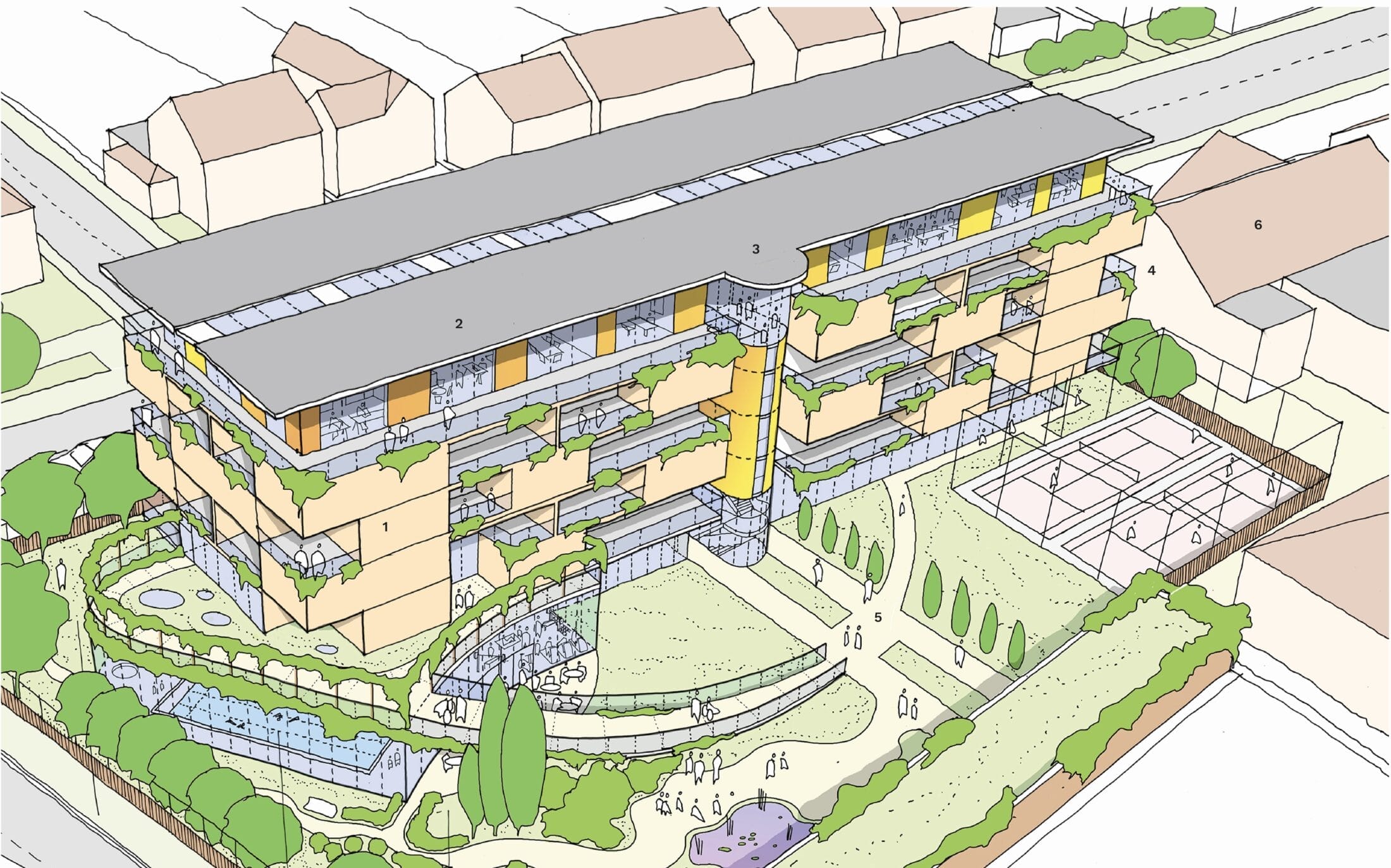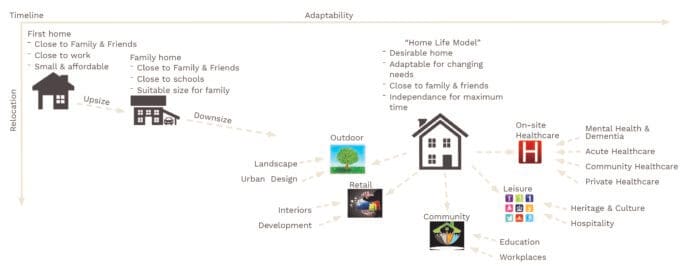
Current model
The result of the current market conditions is a lack of desirable choice for the user, leading to a model where a current home is adapted to suit individual needs, perhaps with care even being brought in as required until the time comes where a move to a dedicated facility is born out of necessity rather than a lifestyle choice. Once on this pathway, the user is on a “conveyor belt” of care types.

Proposed model
HLM’s model proposes “rightsizing” as a lifestyle choice before the need for care accommodation becomes a necessity. This model proposes to make elderly care accommodation desirable and flexible, to encourage users not to delay the move out of the family home. Once the move has been made the flexibility will allow them to continue to reside in their new home as their needs change and adapt.

The current Elderly Care Sector

Typical extra care layout
While offering a level of flexibility and social engagement in the later stages of life, these facilities do not address the real issues concerning elderly housing. Primarily these facilities are sterile, socially engineered silos that offer little flexibility for the adapting needs of the elderly.

Introduction
The aftershock of the housing crisis is felt across multiple sectors of public policy, not least in housing for the elderly and healthcare in general. Figures suggest the 55 – 79 age group are sitting on £720bn worth of homes, with a quarter of this age group considering downsizing but are put off by the lack of quality and attractive options to meet their changing needs. This is solvable; lack of choice, quality and flexibility can be addressed. Sensitivity to the importance of health, well-being and community can reframe the options.
With life expectancy increasing, more and more people are adapting their existing homes beyond their suitability, to be more accessible as they grow older. Without the environment being considered holistically, this serves only as a temporary plaster.
Inevitably the time comes where your “adapted” home is no longer suitable and the occupier is, at best in and out of secondary care or on the “conveyor belt” of elderly care accommodation, moving from extra care to residential care and nursing care. All interspersed with occasional visits back to hospital inpatient care. This not only puts an unsustainable strain on our healthcare system but serves only to increase the speed of declining health in our elderly.
At HLM, we believe a more systemic remedy is required to enable significant and sustainable change. The solution in our view is to facilitate rightsizing out of a lifestyle choice and not necessity.
This has brought us to the conclusion where a two-pronged approach is required in order to tackle this growing problem. The first is to develop a housing model for the elderly that encourages earlier rightsizing, not allowing circumstances and deteriorating health to govern when you must leave your home (To be developed for discussion at the Healthy City Design Conference 2019).
This second approach is to develop suitable elderly care accommodation that allows the user to remain in their chosen accommodation for as long as possible – resisting the conveyor belt of care accommodation brought on by declining health and increased care needed. We propose to show principals such as minimum bedroom numbers (to allow for varying health needs of elderly couples) and the provision of telehealth and ensuring all accommodation is on a single floor will all serve to provide better suited accommodation for the elderly and ultimately lighten the load on the traditional healthcare system.
This approach is where we intend to focus our poster for European Healthcare Design 2019, concentrating on the importance of “Ageing in Place” and the home’s ability to pro-vide healthcare, thus relieving stretched hospital services through telehealth, in-built flexibility and the ability to mould around our healthcare needs.


Rightsizing Model
Creating a desirable and flexible environment to engage with potential users, encourage rightsizing as a lifestyle choice and provide the necessary support as the occupiers needs change over time.
- Private outdoor space above minimum planning standards
- Internal area above minimum guidelines
- Aesthetic: attractive, light & modern
- Multi-generational accommodation
- Dedicated support & community space
- Urban location
- Private Terrace
- All areas wheelchair accessible
- Telehealth provision for non acute care needs
- Single storey living accommodation
- Minimum 2 bedrooms for flexible living conditions
- Structural flexibility for hoist/ handrail provision
- Above minimum space standards suitable for Rightsizing
- Internal social balcony
Conclusion
NHS
Truly flexible elderly housing with the right healthcare provision will serve to decrease the demands on the NHS, especially within an acute setting.
Housing
Serving the demand for suitable elderly living accommodation, significant proportions of the current housing capital will begin to re-enter the market. This will serve to give the housing sector a much needed supply boost, ultimately resulting in lower housing prices.
Users
Offering desirable housing for the elderly will enable the ageing population to take control of their own future. Living in suitable accommodation within the right surroundings and the right support will increase independence and allow users to remain in their new home for longer.
Investors
With entry into retirement living being put off by users, offering a more desirable model to engage with the younger pensioner will create an untapped revenue stream for developers, operators and investors.
